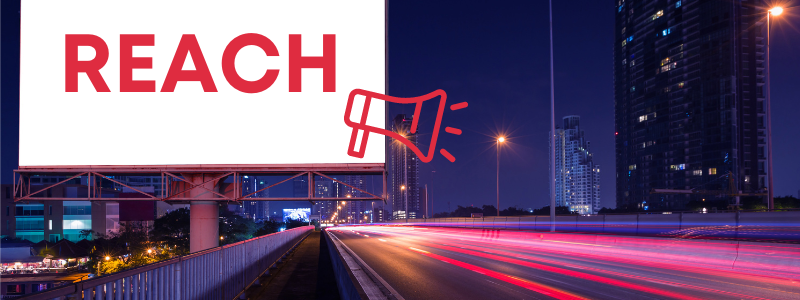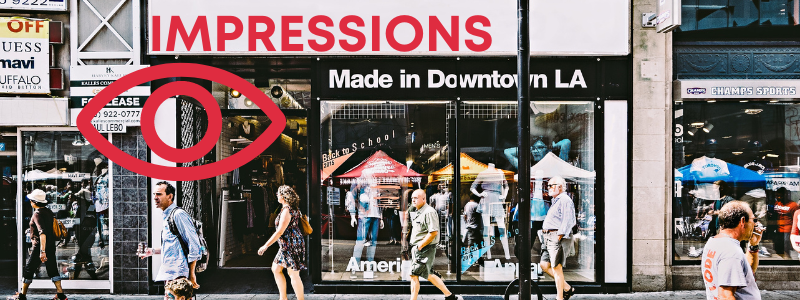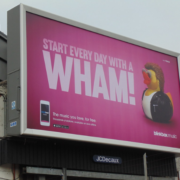In marketing and advertising, the Rule of 7 is a common concept that states that your potential customer needs to see or hear your brand name roughly 7 times to convert. This is one of the reasons that billboards are so important for companies who want to attract their clients and grow their customer base. However, what are the main differences between impressions vs reach?
As a local leading media company, bMedia’s goal is to provide advertising vehicles that make your message get through to your target market to solidify your brand image and/or increase your sales through impact, quality, innovation, and distinct services.

What is Reach and Why is It Important?
Reach is defined by Hootsuite as being the number of people who have seen your ad at least once and can be categorized as either organic, paid, or viral.
Organic reach refers to the number of individual people who saw your content through their timelines or news feed on their own.
Paid reach is the number of people who saw content that was paid for, such as an ad.
Viral reach is the number of people who saw your content because one of their friends interacted with it.
Reach is an important metric to use when considering your marketing campaign because it counts the unique size of your audience; having your reach outlined helps you when you’re trying to understand the impact of your content.
Is Reach the Same as Impressions?
Reach is not to be confused with an Impression. However, when it comes to impressions vs reach, both are equally important metrics for tracking the success of your billboards and campaigns.
Where reach is how many people have seen your content, Impressions are the number of times your content has been displayed to your audience, regardless of if they clicked on it or not. Impressions may show up on your audience’s timeline without them having seen or taken it in. Furthermore, it still counts as an impression simply because it appeared on their web page regardless of whether it garnered engagement.
For example, a piece of content posted on Instagram may pop up on someone’s timeline, and whether they clicked on it or simply scrolled past it, it is still considered an impression.
Which is Better – Reach or Impressions?
There are plenty of similarities between impressions vs reach, but is one better than the other?
When strategizing a new campaign, you want to be sure of which metrics you’re measuring advertising effectiveness and success.
Each Key Performance Indicator (KPI) has a different outcome in terms of success and completely depends on your goals. If you’re unsure whether the amount of ads you’re putting out is too little or too much, you’d want to track impressions. If your ad is sent out and has little engagement or a low conversion rate (someone taking the action you want). Each gives you different information and campaign insight about your ad and content performance to figure out the effectiveness and any changes you may need to make along the way.

What Is An Impression on a Billboard and How Do You Measure It?
While social media has tons of analytic tools at your disposal, outdoor advertising options (OOH) are a little trickier to track. To do this, you will need a combination of strategies from multiple sources to calculate your success.
Billboards are the most common for those that are on the road or even just walking down the street – as we all can attest to, they are everywhere. The size of these ads is created as such to draw your audience in through their regular routines. Not only that, but they are massive, sturdy structures that can be seen from far away – quite literally hard to miss.
When it comes to OOH advertising, tracking Impressions is a little different. Rather than having data on how many people were exposed to your ad, it’s important to be mindful of activity in the area and the level of engagement. This is mostly calculated through traffic patterns to estimate the number of people that saw the ad through the Traffic Audit Bureau (TAB) using surveys, market research, and more to measure the number of impressions. This information helps you define demographics, interests, consumer characteristics, time spent near the ad, vehicle speed, and much more.
How to Measure Reach with Billboards?
In OOH Advertising, Impressions calculates how many times a person sees your ad on average, where Reach focuses on the bigger picture – the entire population – and the number of times a person has seen your billboard at least once. Reach is calculated technically – using road type, distance on the road, size, and billboard characteristics, to name a few.
Using Reach and Impressions to gauge the performance of your advertisement are great indicators of success, as well as what you can do better next time.
Why Should I Use A Billboard in My Marketing Strategy?
Billboards have been used for years, and are not going out of style anytime soon.
Their effectiveness is unmatched, sometimes without your audience even recognizing the effects of the persuasiveness taking place. You may have used them on a long road trip to play the alphabet game, intaking more information than you thought.
They are psychological attention-grabbers, feeding your audience different messages and calls-to-action (CTAs) with your brand.
On the internet, your audience has more control over whether they see an advertisement, or how often they are on their phones or laptops at all. With billboards, they are physically and mentally hard to ignore, as they surround much of our daily lives and routine. By implementing billboards into your marketing strategy, you take back some of that control and can influence your target audience more easily.
Choosing the right group to help you find that client base is even more crucial in your advertising strategy plan – which is why bMedia statistically has the highest consumer traffic for their island-wide billboards.
bMedia is the perfect agency to help you reach your audience when you want, where you want.










 787 792 4113
787 792 4113
